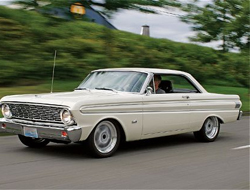Ford Falcon
 After recession hit the US economy in the late 1950s, car buyers started to demand smaller ‘compact’ cars, and the Falcon was Ford’s response.
After recession hit the US economy in the late 1950s, car buyers started to demand smaller ‘compact’ cars, and the Falcon was Ford’s response.
Smaller than the established Fairlane saloon, but still big enough to fit the family and everything it needed to haul, and fitted with a 144ci (2360cc) six-cylinder engine giving comparatively good fuel economy, the Falcon was just the right car at just the right time. It quickly became one of Ford’s best sellers.
In 1963 the Falcon went in a new direction, with the introduction of a 164bhp, 260ci (4261cc) V8 engine option. To publicise this new ‘Falcon Sprint’ Ford entered a team of three cars in the tough Monte Carlo Rally, prepared by Holman and Moody, and run form England by Jeff Uren. Anne Hall’s car was delayed by bad weather, Swede Bo Ljungfeldt’s recovered from clutch problems to win the final stages and finish 43rd overall, while Peter Jopp’s Falcon managed 35th overall and won its class.
Eight Falcons were entered in the 1964 Monte Carlo Rally, with glassfibre body panels to reduce weight and 305bhp 289ci (4736cc) engines. All eight cars successfully finished the rally, and this time Ljungfeldt brought his car home in second place overall.
But the popularity of the Falcon Sprint had already peaked. The stylish new Ford Mustang was taking over, and when a new Falcon was introduced in 1965 it was bigger car based on a shortened Fairlane platform. And the rallying days of Ford’s V8-powered American cars were over.
• Engine: 4261cc 90-degree V8
• Bore x stroke: 96.5 x 72.9mm
• Valvegear: Pushrod-operated overhead valves
• Fuel system: Single two-barrel carburetor
• Power: 164bhp at 4400rpm
• Suspension: Front: wishbones, coil springs and anti-roll bar; rear: live axle with leaf springs
• Wheels: 14in steel wheels
• Brakes: Drum brakes all round, servo assisted
• Top Speed: 107mph (172km/h)